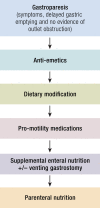Diabetic Gastroparesis
- PMID: 31081877
- PMCID: PMC6736218
- DOI: 10.1210/er.2018-00161
Diabetic Gastroparesis
Abstract
This review covers the epidemiology, pathophysiology, clinical features, diagnosis, and management of diabetic gastroparesis, and more broadly diabetic gastroenteropathy, which encompasses all the gastrointestinal manifestations of diabetes mellitus. Up to 50% of patients with type 1 and type 2 DM and suboptimal glycemic control have delayed gastric emptying (GE), which can be documented with scintigraphy, 13C breath tests, or a wireless motility capsule; the remainder have normal or rapid GE. Many patients with delayed GE are asymptomatic; others have dyspepsia (i.e., mild to moderate indigestion, with or without a mild delay in GE) or gastroparesis, which is a syndrome characterized by moderate to severe upper gastrointestinal symptoms and delayed GE that suggest, but are not accompanied by, gastric outlet obstruction. Gastroparesis can markedly impair quality of life, and up to 50% of patients have significant anxiety and/or depression. Often the distinction between dyspepsia and gastroparesis is based on clinical judgement rather than established criteria. Hyperglycemia, autonomic neuropathy, and enteric neuromuscular inflammation and injury are implicated in the pathogenesis of delayed GE. Alternatively, there are limited data to suggest that delayed GE may affect glycemic control. The management of diabetic gastroparesis is guided by the severity of symptoms, the magnitude of delayed GE, and the nutritional status. Initial options include dietary modifications, supplemental oral nutrition, and antiemetic and prokinetic medications. Patients with more severe symptoms may require a venting gastrostomy or jejunostomy and/or gastric electrical stimulation. Promising newer therapeutic approaches include ghrelin receptor agonists and selective 5-hydroxytryptamine receptor agonists.
Copyright © 2019 Endocrine Society.
Figures



References
Publication types
MeSH terms
Grants and funding
LinkOut - more resources
Full Text Sources
Medical

